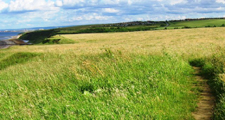Limestone Coast
Land Management
Natural Features, Watercourses and Wetlands
- Allow natural processes to shape the coast, avoiding the use of sea defences unless absolutely necessary.
- Monitor the natural erosion of colliery wastes from beaches – removing any hazardous or unsightly materials exposed.
- Manage access to the foreshore and in particular prevent vehicular access.
Farmland
- Conserve and manage coastal grasslands to maintain and enhance their diversity. Adopt appropriate stocking levels or cutting regimes to maximise flowering and seed setting. Avoid improvements such as drainage or reseeding and the use of fertilisers and herbicides.
- Revert cliff-top arable to species-rich grassland. Use seed or hay crops from local sources.
- Avoid permanent fencing – maintain visual openness.
- Allow areas of open scrub to develop in coastal grasslands – and particularly in and around shallow cliff-top denes – to create visual and ecological diversity and a more ‘natural’ character.
- Control erosion of dune grasslands by restricting or guiding public access and reinforcing well used routes with natural materials.
Trees, Woodlands and Forestry
- Protect and conserve broadleaved woodlands and scrub in coastal denes and the sides of dene-mouths. Progressively remove non-native species and restock using natural regeneration or planting native species of local origins.
- Plant new native ash (limestone outcrops) and oak (boulder clay) woods and scrub (Hazel, Hawthorn, Blackthorn, Juniper) in sheltered denes, avoiding areas of nature conservation interest.
- Plant areas of coastal scrub to screen roads and railway lines, settlement edges, allotment gardens and industrial land.
Development
Agricultural Buildings
- Where possible site new farm buildings away from the coastal strip on the adjacent Coastal Limestone Plateau.
- Reduce the impact of larger modern buildings by careful selection of colour, breaking up mass and planting screening belts of native coastal scrub.
Energy, Telecommunications and Infrastructure
- Avoid locating tall structures like masts and turbines on the coastal strip – where possible site them on the adjacent Coastal Limestone Plateau, either in urban areas or close to existing buildings, tree groups or woodland edges.
Housing and Economic Development
- Keep the undeveloped coastline free from further development. Ensure that any essential facilities are carefully sited and designed to minimise their impact.
- Screen any essential new development with substantial structure planting of native coastal scrub.
Tourism and Recreation
- Tourism and recreational development should be undertaken in such a way as to avoid an urbanising influence on the increasingly natural landscape of the coast.
- In designing new facilities including footpath, car parks, seating areas and signage use natural materials such as local limestone. Adopt a low key and vernacular design idiom and avoid urban or municipal characteristics.
Further Information


